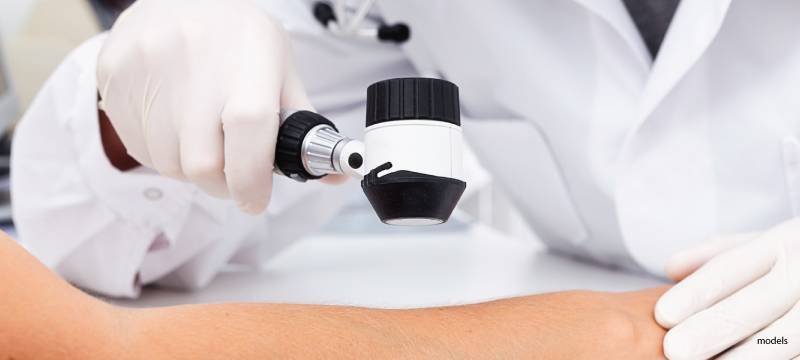Bacterial vs. Viral Skin Infections: What’s The Difference?

The skin, our body’s resilient shield, is not impervious to invaders. Whether it is a pesky bacterium or a stealthy virus, our skin can become a battleground for infections, leading to discomfort and distress. Deciphering the source of infection can sometime be difficult, but understanding the root cause of infection, bacterial or viral, is crucial for both an accurate diagnosis and effective treatment plan.
In this blog post, we will explore the nuances between bacterial skin infections and viral skin infections, covering the symptoms, preventative measures, and treatment options for both inflictions.
What is a Bacterial Skin Infection?
A bacterial skin infection is a condition caused by bacteria entering the skin through cuts, abrasions, insect bites, or other breaks in the skin’s protective barrier. These infections can range from mild to severe and may affect different layers of the skin, including the epidermis (outer layer) or the deeper dermis and subcutaneous tissue. Common bacterial skin infections include cellulitis, erysipelas, impetigo, folliculitis, furuncles, and carbuncles.
Treatment for bacterial skin infections typically involves topical or oral antibiotics to eliminate the bacteria causing the infection. In mild cases, over-the-counter antiseptic creams or ointments may be sufficient, while more severe infections may require prescription-strength antibiotics prescribed by a healthcare professional.
What is a Viral Skin Infection?
Viral skin infections are caused by viruses and can spread easily through direct contact or airborne particles. Unlike bacterial infections, viral infections cannot be treated with antibiotics. Common viral skin infections include chickenpox, measles, shingles, herpes simplex, warts, molluscum contagiosum, and hand, foot, and mouth disease.
Treatment for viral skin infections primarily focuses on managing symptoms and supporting the body’s immune response. Antiviral medications may be prescribed in some cases to reduce viral replication and alleviate symptoms. However, many viral skin infections resolve on their own over time as the body’s immune system clears the virus.
How to Tell the Difference?
Differentiating between bacterial and viral skin infections can be challenging due to overlapping symptoms. However, there are some key distinctions:
Common Symptoms of Bacterial Skin Infection:
- Redness, swelling, and warmth around the affected area
- Pain or tenderness
- Pus-filled blisters or sores
- Fever and chills in severe cases
Common Symptoms of Viral Skin Infection:
- Rash or blisters
- Itching or tingling sensation
- Flu-like symptoms such as fever, fatigue, and body aches
- Swollen lymph nodes
Bacterial infections typically start in a specific area and may spread if left untreated. On the other hand, viral infections can manifest with systemic symptoms affecting the entire body.
Common Types of Bacterial Skin Infection
- Cellulitis: A bacterial infection affecting the deeper layers of the skin, often caused by Staphylococcus or Streptococcus bacteria.
- Erysipelas: Characterized by red, swollen patches on the skin, usually on the legs or face, caused by Streptococcus bacteria.
- Impetigo: Common in children, this highly contagious infection results in red sores or blisters that ooze and crust over.
- Folliculitis: Infection of the hair follicles, leading to red bumps or pustules.
- Furuncles: Also known as boils, these painful, pus-filled lumps form around hair follicles.
- Carbuncles: Clusters of furuncles that cause deeper, more severe infections.
Common Types of Viral Skin Infection
- Chickenpox: Characterized by itchy red spots that develop into fluid-filled blisters, caused by the varicella-zoster virus.
- Measles: A highly contagious viral infection causing a distinctive red rash, fever, cough, and runny nose.
- Shingles: Caused by the reactivation of the varicella-zoster virus, resulting in a painful rash with blisters.
- Herpes simplex: Causes cold sores or genital herpes lesions, often recurring due to the herpes simplex virus.
- Warts: Benign growths caused by human papillomavirus (HPV), appearing as small, rough bumps on the skin.
- Molluscum contagiosum: Contagious viral infection causing small, round, flesh-colored bumps on the skin.
- Hand, foot, and mouth disease: Common in children, this viral infection causes sores or blisters on the hands, feet, and in the mouth.
Preventing Skin Infections
Prevention is key to avoiding both bacterial and viral skin infections. Simple measures include:
- Frequent handwashing: Especially after using the restroom, before eating, and after touching potentially contaminated surfaces.
- Proper wound care: Keep cuts, scrapes, and wounds clean and covered until healed to prevent bacterial infections.
- Avoiding close contact: Steer clear of individuals exhibiting symptoms of infection and refrain from sharing personal items.
- Hygienic practices: Regularly clean and disinfect surfaces, particularly in shared spaces like gyms and locker rooms.
Treating Skin Infections
Treatment for skin infections depends on the type and severity:
- Mild infections: Often resolve on their own or with over-the-counter remedies such as topical creams or antiseptics.
- Moderate to severe bacterial infections: May require antibiotics prescribed by a healthcare professional to eliminate the bacteria causing the infection.
- Viral infections: Focuses on managing symptoms and supporting the immune system’s natural response. In some cases, antiviral medications may be prescribed to reduce viral replication.
- Consulting a dermatologist: If a skin infection is severe, recurring, or not responding to treatment, it’s important to seek professional medical advice.
Understanding the differences between bacterial and viral skin infections is essential for effective management and prevention. By practicing good hygiene, being vigilant for symptoms, and seeking prompt medical attention when needed, you can minimize the risk of skin infections and maintain healthy skin.
Disclaimer: The contents of the Westlake Dermatology website, including text, graphics, and images, are for informational purposes only and are not intended to substitute for direct medical advice from your physician or other qualified professional.
